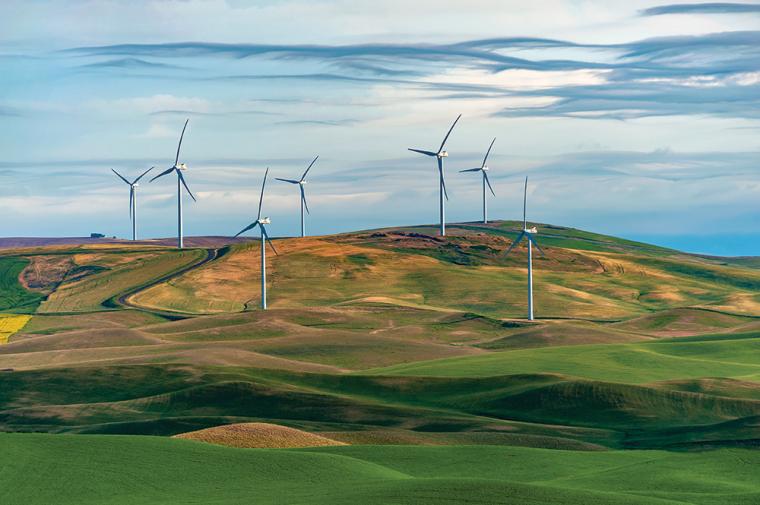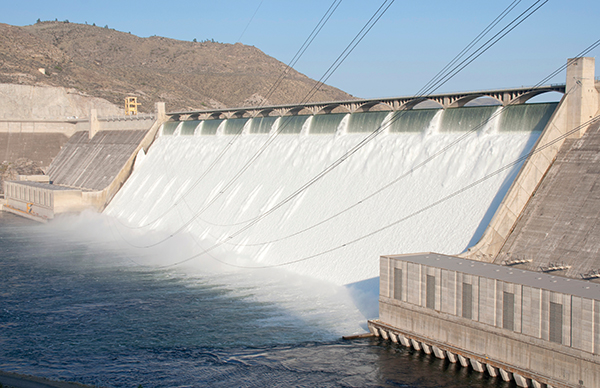
Nearly a century ago, the surge of electricity created by hydropower propelled Washington State out of the Great Depression. Construction of hydroelectric dams spurred jobs and poured much-needed irrigation water throughout dry Eastern and Central Washington farmland.
Hydropower also fueled the manufacturing facilities that produced aluminum, the essential component of aircraft manufacturing at Boeing in Seattle during World War II. President Truman said at the time that the war would have been almost impossible to win without the power generated by the Grand Coulee Dam.
Today, while roughly half of the state runs on hydropower, other forms of energy contribute a stable and sustainable source of energy to the region’s power supply. Wind power, for example, now represents about 17 percent of the region’s generating capacity, and it continues to grow. Washington State is paving the way for a new generation of transportation that will run on hydrogen, electricity and biofuels.
These endeavors reflect a statewide goal of becoming 100 percent reliant on non-carbon-emitting energy by 2045. In terms of the big picture, this philosophy is good for both sustainability and job creation.
The Clean Jobs America 2023 report by E2 found that clean energy accounted for 40 percent of all energy jobs in the year prior, one out of 30 of all net-new jobs in the U.S.
The Clean Investment Monitor (CIM) quantifies these investments in communities across America. Among the companies that CIM tracks in Washington is a few star performers that are making a lasting contribution to the state’s sustainable future.
Group14: Building the World’s Largest Advanced Silicon Battery Materials Factory

Companies across the state are making significant investments in clean energy. One standout example is Group14 Technologies and its Battery Active Materials (BAM-2) factory now under construction in Moses Lake. This factory will expand the company’s commercial-scale manufacturing capacity, complementing the existing Group14 factory in Woodinville. That facility currently produces SCC55TM, an advanced silicon battery material that delivers higher energy density and faster charge rates for applications like electric vehicles and smartphones.
The BAM-2 factory reached mechanical completion in late 2024 and will create up to 200 jobs in Moses Lake. Additionally, Group14 already partners with more than 20 community-based organizations to drive local job creation, support upskilling educational opportunities and ultimately strengthen the domestic supply chain to improve global competitiveness for U.S. battery manufacturing.
Visionary businesses like Group14 are contributing to this sustainable, low-to-zero emissions future. Plenty of great partners share a similar vision and are eager to collaborate on an exploration of new technologies, products, processes and markets for sustainable, clean energy.
Other Emerging Opportunities in Washington
Other sustainability-led businesses are thriving in Washington State, including:
Sustainable aviation fuel. Several new facilities are currently developing new methods for making sustainable aviation fuel at scale. To support the growth of SAF production, the state legislature is helping streamline permitting and environmental reviews for plant construction, making Washington a leader in this growing industry.
Electric aircraft. The electrification of commuter and corporate aircraft is another exciting opportunity. Building on the state’s century-long domination of U.S. aerospace, new players are coming to market, such as Aviation. The company’s all-electric Alice is built from the ground up to fill the need for short-range, non-polluting aircraft that can serve passenger and cargo routes of up to 250 miles. Alice uses another Washington innovation, magniX’s magni650 electric motors, to power the aircraft.
Vessel electrification. Washington’s economy is deeply rooted in its maritime industry. From its world-class ports and shipyards to fishing fleets and cruise lines, leading companies are exploring new ways to adopt technologies that will decarbonize marine traffic. This includes electrifying the state’s fleet of ferries, which serve as a marine highway. The goal is to reduce the carbon dioxide emissions among the entire fleet by 76 percent and nitrous oxide emissions by 94 percent.
Farming. Agriculture contributes more than 669.5 million metric tons of carbon dioxide equivalents in the U.S., mainly in the form of nitrous oxide and methane. Washington companies are working on reducing the state’s contribution on several fronts. Using water instead of fossil fuel to manufacture fertilizer is one promising option. Other companies are using zero or low-carbon technologies to turn unsellable and discarded food waste into renewable natural gas, feedstock and fertilizer.
Power production. A move away from fossil fuels requires new ideas in power production. Solar, biomass, wind and tidal energy systems are already part of the state’s growing clean energy portfolio. Increased battery production and grid management technologies are also moving from the drawing board to the factory floor.
Hydrogen. Washington is part of a consortium of states designated as a Hydrogen Hub by the U.S. Department of Energy. This designation means an infusion of up to $1 billion in capital to fund a range of programs and projects across the state to harness the potential of hydrogen as a clean, sustainable and regenerative energy source for vehicles, aircraft and marine vessels.
A recent study led by the real estate technology company ProptechOS awarded Seattle recognition as the Smartest City in the U.S. based on 16 indicators that spotlight sustainability as one of three primary categories. Technology infrastructure and connectivity, along with a strong tech job market, round out the other key categories that led to the recognition.
The innovations in clean energy and industry that have originated in Washington State will continue to benefit the country as a whole, and clean energy – as well as Washington State – will remain a frontier for better ways to power the future.
One of the most exciting aspects of this undertaking is the potential for future energy production to be not only clean but also inclusive. A sea change in the way Washington thinks about, produces and manages power will provide new opportunities for communities across the state and for residents to enjoy clean, sustainable energy for generations to come. T&ID

